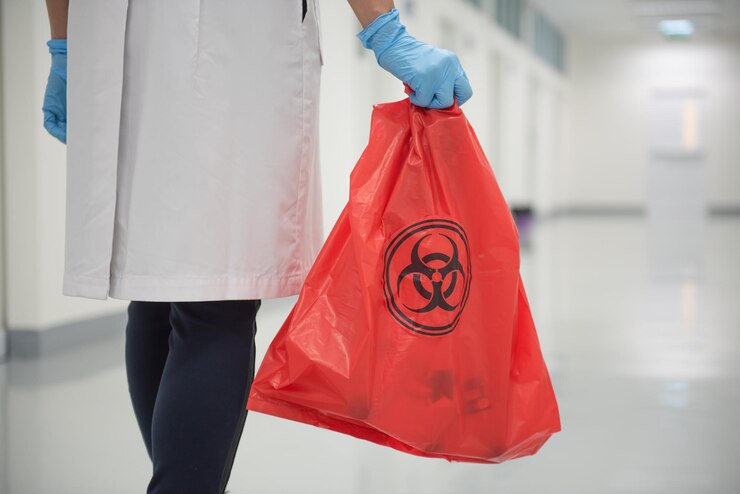
When it comes to handling medical and hazardous waste, safety and compliance aren’t just recommended—they’re essential. One of the simplest yet most important systems used in hospitals, laboratories, and healthcare facilities is the color-coded bio hazard bag system. Among these, red and yellow bio hazard bags play a critical role in the segregation and safe disposal of various types of medical waste.
In this blog, we’ll explore the difference between red and yellow bio hazard bags, what goes in each, and why proper segregation is crucial. We’ll also touch on how bio medical waste bags and biohazard waste bags ensure regulatory compliance and help maintain hygiene in high-risk environments.
Why Color Coding Matters in Bio Hazard Waste Management
Biohazard waste, if not handled properly, can spread infections, harm the environment, and pose serious health risks to sanitation workers, patients, and healthcare professionals.
Color coding helps in:
- Proper segregation of waste at the source
- Easy identification and safe disposal
- Compliance with local and global waste management regulations
- Reducing the risk of cross-contamination
The use of color-coded bio medical waste bags is a legal requirement in many countries under biomedical waste rules.
What Is a Bio Hazard Bag?
A bio hazard bag (also written as biohazard waste bag) is a specially designed bag made from high-density polyethylene or similar material. It is resistant to punctures, leaks, and tears and is used to collect and dispose of potentially infectious waste.
These bags typically come with:
- The biohazard symbol clearly printed
- Specific color coding for waste classification
- High-quality sealing or tie options for safe closure
- Clear labels for waste tracking
Red Bio Hazard Bag: What Goes Inside?
Red bio hazard bags are used for infectious and non-sharp waste that is contaminated with blood, bodily fluids, or infectious agents. These bags are widely used in hospitals, labs, and clinics to manage non-anatomical waste.
Waste Examples for Red Bags:
- Tubing, IV sets, and catheters
- Blood bags (empty or partially full)
- Used gloves, aprons, and surgical gowns
- Contaminated cotton swabs or dressings
- Soiled plastic or rubber items used during treatment
These bags are typically autoclaved or microwaved for disinfection before final disposal.
Yellow Bio Hazard Bag: What Goes Inside?
Yellow bio hazard bags are used to collect anatomical waste and highly infectious items that require incineration. These bags are critical for handling waste that cannot be disinfected or recycled and must be destroyed at high temperatures.
Waste Examples for Yellow Bags:
- Human tissues, organs, and body parts
- Animal carcasses used in lab testing
- Pathological waste
- Expired or discarded medicines
- Soiled sanitary waste (from isolation wards or infectious cases)
Since this type of waste carries a higher risk of spreading disease, it is usually incinerated in specially licensed facilities.
Key Differences: Red vs Yellow Bio Hazard Bags
| Feature | Red Bio Hazard Bag | Yellow Bio Hazard Bag |
| Waste Type | Infectious plastics, PPE, tubing | Anatomical waste, tissues, and organs |
| Disposal Method | Autoclaving, shredding | Incineration |
| Typical Use Areas | General wards, OPD, emergency | Surgical units, pathology labs |
| Reusability | Often recyclable after disinfection | Not recyclable, must be fully destroyed |
Why Proper Usage Is So Important
Incorrect use of bio hazard bags can lead to:
- Infection spread among healthcare staff
- Legal issues and penalties for medical facilities
- Environmental pollution
- Improper disposal of recyclable or incinerable waste
Using the correct bio medical waste bags is not just about following rules—it’s about maintaining a safe, clean, and ethical healthcare environment.
Regulations You Should Know
Most countries have strict regulations for biohazard waste bag usage. In India, for example, the Bio-Medical Waste Management Rules, 2016 mandate the use of color-coded bags and proper waste segregation.
Failure to follow guidelines may result in:
- Fines and legal action
- License suspension for facilities
- Reputational damage
Always source your bio hazard bags from certified vendors and ensure your staff is well-trained in waste classification.
Additional Tips for Bio Hazard Waste Management
- Always label the bags with the type of waste, source, and date
- Never mix waste types in a single bag
- Don’t overfill the bags; seal them securely
- Use PPE when handling bio medical waste bags
- Keep a record of daily waste generation and disposal
Final Thoughts
Understanding the color codes of bio hazard bags, especially red and yellow, is vital for anyone handling medical or infectious waste. Red bags are designed for infectious plastics and PPE, while yellow bags handle anatomical and pathological waste. Both play a critical role in protecting public health and the environment.
By using the right bio medical waste bags and following regulations, healthcare providers can ensure safe, legal, and responsible waste disposal. Whether you’re a clinic owner, hospital manager, or healthcare worker, mastering the use of biohazard waste bags is a step toward a cleaner, safer, and more sustainable future.

